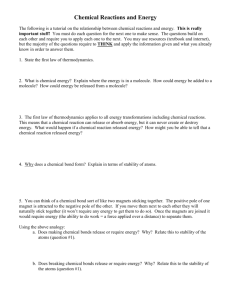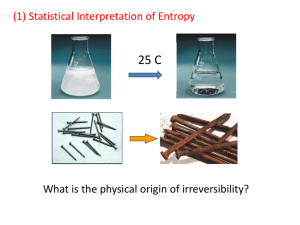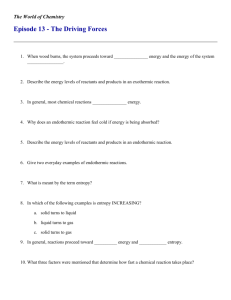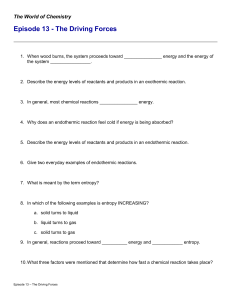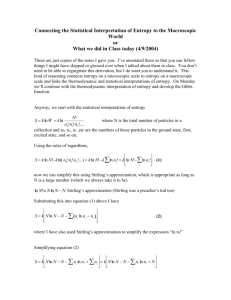Kandace's Lab Activites (2) - ESCI350-351-2012
advertisement
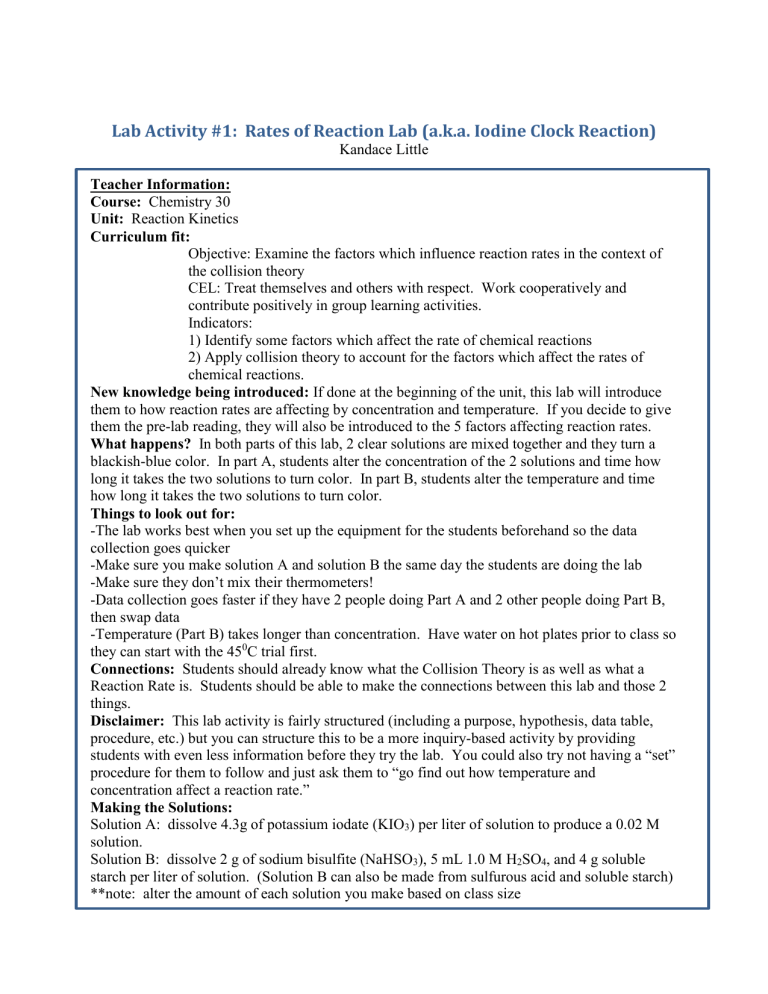
Lab Activity #1: Rates of Reaction Lab (a.k.a. Iodine Clock Reaction) Kandace Little Teacher Information: Course: Chemistry 30 Unit: Reaction Kinetics Curriculum fit: Objective: Examine the factors which influence reaction rates in the context of the collision theory CEL: Treat themselves and others with respect. Work cooperatively and contribute positively in group learning activities. Indicators: 1) Identify some factors which affect the rate of chemical reactions 2) Apply collision theory to account for the factors which affect the rates of chemical reactions. New knowledge being introduced: If done at the beginning of the unit, this lab will introduce them to how reaction rates are affecting by concentration and temperature. If you decide to give them the pre-lab reading, they will also be introduced to the 5 factors affecting reaction rates. What happens? In both parts of this lab, 2 clear solutions are mixed together and they turn a blackish-blue color. In part A, students alter the concentration of the 2 solutions and time how long it takes the two solutions to turn color. In part B, students alter the temperature and time how long it takes the two solutions to turn color. Things to look out for: -The lab works best when you set up the equipment for the students beforehand so the data collection goes quicker -Make sure you make solution A and solution B the same day the students are doing the lab -Make sure they don’t mix their thermometers! -Data collection goes faster if they have 2 people doing Part A and 2 other people doing Part B, then swap data -Temperature (Part B) takes longer than concentration. Have water on hot plates prior to class so they can start with the 450C trial first. Connections: Students should already know what the Collision Theory is as well as what a Reaction Rate is. Students should be able to make the connections between this lab and those 2 things. Disclaimer: This lab activity is fairly structured (including a purpose, hypothesis, data table, procedure, etc.) but you can structure this to be a more inquiry-based activity by providing students with even less information before they try the lab. You could also try not having a “set” procedure for them to follow and just ask them to “go find out how temperature and concentration affect a reaction rate.” Making the Solutions: Solution A: dissolve 4.3g of potassium iodate (KIO3) per liter of solution to produce a 0.02 M solution. Solution B: dissolve 2 g of sodium bisulfite (NaHSO3), 5 mL 1.0 M H2SO4, and 4 g soluble starch per liter of solution. (Solution B can also be made from sulfurous acid and soluble starch) **note: alter the amount of each solution you make based on class size Pre-Lab Reading: The rate of a chemical reaction is the time required for a given quantity of reactants to be changed to product. Reaction rate usually is expressed in terms of moles per unit time. This rate is affected by several factors, including the nature of reactants, concentration of the reactants, temperature, pressure, and the presence of catalysts. In this experiment, you will study the effects of temperature and concentration. A chemical reaction is the result of effective collisions between particles of reactants. Increasing the temperature of a system raises the average kinetic energy of the particles of the system. This results in more collisions and, of greater importance, more effective collisions per unit time. This affects the rate of the reaction. At constant temperature, increasing the concentration of one or more of the reactants increases the number of particles present and, hence, the number of collisions. This affects the rate of the reaction. In this experiment, two solutions will be mixed, and the completion of the reaction will be marked by a color change. One solution contains the iodate ion (IO3-). The other contains the hydrogen sulfite ion (HSO3-) and soluble starch. The entire reaction takes place in two stages. The ionic equations for these stages are: 1. IO3- (aq) + 3HSO3- (aq) I-(aq) + 3SO42- (aq) +3H+ (aq) 2. 5I- (aq) + 6H+ (aq) + IO3- (aq) 3 I2 (aq) + 3 H2O (l) In the presence of starch molecules (not shown), molecular iodine (I2) produced a characteristic blue color. The rate of the entire reaction can be determined by timing the interval between the time the two solutions are mixed and the appearance of the blue color. By varying the concentration of one of the reactants (at constant temperature) and then varying the temperature along, you can observe and record the effects of these two factors on reaction rate. This experiment should provide a better understanding of reaction rates and the factors that affect these rates. Purpose: Study the effect that changing the concentration of a reactant has on the rate of a chemical reaction. Study the effect that changing the temperature has on the rate of a chemical reaction. Formulate hypotheses about how reaction rates are affected by changes in temperature and in concentration of reactants. Materials: (for each group) -250 mL beaker -timer/stop watch with second hand -100 mL beakers (4) -safety goggles -10 mL graduated cylinders (2) -lab apron or coat -medium size test tubes (2) -thermometer -Solution A (with IO3 ion) -distilled water -Solution B (with HSO3- ion and soluble starch) -ice cubes Safety: Avoid spilling reagent solutions on your skin or clothing. Wash off any spills immediately with cold tap water. Always wear safety goggles and a lab apron or coast when working with chemicals. Procedure: Part A 1. Using a clean and dry 10 mL graduated cylinder, measure exactly 10.0 mL of Solution A and pour it into a 100 mL beaker. 2. Using a second 10 mL graduate, measure exactly 10.0 mL of Solution B and pour it into second 100 mL beaker. 3. Prepare to time the reaction. While one lab partner pours Solution A into Solution B, the second partner should immediately start timing the reaction. Pour the solutions back and forth several times from one beaker to the other to ensure thorough mixing. Then allow the mixture to stand. At the instant a color change occurs, the partner timing the reaction should note the elapsed time. Record this in your data list. Rinse and dry the beakers and graduated cylinders. 4. Measure exactly 10.0 mL of Solution B into one of the beakers. Using a clean graduated cylinder, measure exactly 9.0 mL of Solution A into the other beaker. Dilute this solution by adding exactly 1.0 mL of distilled water. Follow the step 3 instructions for mixing the solutions and timing the reaction. Record the elapsed time in your data list. Rinse and dry the beakers and graduated cylinders. 5. Repeat step 4 four more times, using increasingly dilute samples of Solution A. Use the following ratios of Solution A to distilled water (in mL): 8 to 2; 7 to 3; 6 to 4; and 5 to 5. Rinse and dry the beakers and graduated cylinders after each trial. Record elapsed times in Part A of “Observations”. Part B 1. Measure 10.0 mL of Solution A into one test tube and 10.0 mL of Solution B into a second test tube. 2. Half fill a 250 mL beaker with cold tap water. Add ice cubes to the water and stir carefully with the thermometer. Continue stirring (and adding ice as needed) until the temperature of the ice-water mixture is about 5 0C. 3. Place the two test tubes in the ice-water bath and let them stand until the solutions are at the same temperature as the ice water. Always rinse and wipe the thermometer after removing it from a solution. 4. When the solutions are at the same temperature as the ice water, prepare to time the reaction. One lab partner should start timing the reaction the instant the second partner pours Solution A into Solution B. Quickly pour the mixture back and forth from test tube to test tube several times and return the mixture to the ice-water bath. At the instant a color change occurs, note the time elapsed. Measure the temperature of the mixture immediately. Record the exact temperature and elapsed time in your data table. Discard the mixture as instructed. Rinse and dry the test tubes. 5. Repeat step 1. 6. Prepare a water bath at a temperature of about 150C. Repeat steps 3 and 4 are this new temperature. Record your observations in your data table. 7. Repeat these procedures using warm baths at the following temperatures: 250C; 350C; 450C. Use warm tap water to prepare these baths. Rinse and dry the test tubes after each trial. Name: ______________________ Partner(s): __________________________ Rates of Reaction Lab Purpose: Study the effect that changing the concentration of a reactant has on the rate of a chemical reaction. Study the effect that changing the temperature has on the rate of a chemical reaction. Formulate hypotheses about how reaction rates are affected by changes in temperature and in concentration of reactants. Hypothesis: 1) As concentration of reactants increases, the reaction rate will _________________. 2) As temperature of reactants increases, the reaction rate will __________________. Materials and Procedure: SEE HANDOUT Observations: PART A Solution B (mL) 10 10 10 10 10 10 Solution A (mL) 10 9 8 7 6 5 Water (mL) 0 1 2 3 4 5 Time (sec) PART B Trial # 1 2 3 4 5 Temperature (0C) 50C 150C 250C 350C 450C Time (sec) Reaction time (sec) Reaction time (sec) Calculations: 1) Plot your data from Part A on the grid provided. Draw a line through the plotted points to produce a best fit line showing the effect of concentration of reactants on reaction rate. 2) Plot your data from Part B on the grid provided. Draw a line through the plotted points to produce a best fit line showing the effect of temperature on reaction rate. Discussion/Conclusions: Before answering the following questions, think carefully about the difference between reaction rate and time. If the time it takes to complete a reaction goes up (takes longer), then the reaction rate is actually decreased (slowed down). If time decreases, then reaction rate increases. 1) Based on your experimental data, make a general statement (hypothesis) about the effect of concentration of reactants on reaction rate. 2) Make a similar hypothesis about the effect of temperature on reaction rate. 3) From the lab reading, list 5 factors that affect the rate of a reaction. 4) A chemical reaction is the result of effective collisions between particles of reactants. Explain in terms of the “collision theory” how both temperature and concentration of reactants affect the rate of reaction. Conclusion: Was your hypothesis correct? If no, what did you discover actually happened? Pictures from when I did the lab: Temperature Set up The Color Change Mixing Solution A and Solution B Materials for Concentration Lab Activity #2: Reaction Spontaneity Stations Kandace Little Teacher Information: Course: Chemistry 30 Unit: Energy Changes in Chemical Reactions – thermochemistry Curriculum fit: Objective: Understand the reasons why entropy and enthalpy effects are important Indicators: 1) Identify how entropy effects influence chemical reactions. 2) Consider the interaction between enthalpy and entropy in determining whether a reaction is spontaneous. 3) Use the concept of free energy to express the quantitative relationship between entropy and enthalpy. 4) Predict spontaneity of reactions using ∆G0 = ∆H0 - T∆S0 New knowledge being introduced: Assuming the students have already been introduced to the concept of spontaneous processes and entropy, this lab will introduce students to 5 different scenarios where they can predict what will happen to the entropy of a system. Instead of just giving students the answers of what would happen to the entropy in each situation, I had them explore and experience for themselves firsthand what would happen. What happens? Divide the students up into groups of 4 or 5 students and have them go to the 5 stations around the room. (I told them to just go to one because of time constraints, but you could have them go to all stations if you would like) Students follow the directions on the station worksheet and answer the few questions that are also on the worksheet. Things to look out for: -Remember to turn on the hot plates for the temperature station before class and have enough beakers for multiple groups -Don’t give them the answers! It’s much more rewarding watching them figure them out for themselves. Simply walk around and monitor each station, asking prompting questions if need be Connections: After this lab, students would be able to make the connections between spontaneity and entropy. You would follow up this lab activity with introducing them to Gibbs free energy because it relates enthalpy, entropy, and spontaneity. Things I would change for next time: -I would actually make them worksheets for each station and then not bring the class back together to fill out the fill-in-the-blank notes after the activity. Perhaps the notes could become the worksheets. The way I had them do it was just answering the questions on loose leaf and then coming back as a class to fill in the notes -I would let each group go to each station instead of just one. This would change the format I had of the expert group reporting back to the class, but that way everyone would get to experience every station for themselves which would help them understand each better -Change a couple stations to be more “hands-on” -Take titles off of each station to make it more “discovery/inquiry” for students Fill in the blank notes that I used before & after the activity: Station Cards: (to be set up in different spaces around the laboratory/classroom with the appropriate materials at each station) 1. Changes of State You have 3 objects. One is a solid, one is a liquid and one is a gas (in the bottle). Think about how tightly packed the particles are in each. Below is a diagram to help you see the particles in each of the objects you have. Remembering that entropy is the disorder or randomness of the particles, which of your three states of matter would have the highest entropy? Write the 3 states of matter in increasing order of entropy. 2. Dissolving Gas in a Solution Examine the picture below. It is showing a gas being dissolved in a solution. Fact: The gas has high entropy (a lot of disorder). Based on the picture and the FACT that was given to you, what do you think happens to the entropy (disorder or randomness) when a gas is dissolved into a solution (water)? Why do you think this? 3. Number of Gaseous Particles At this station, every group member needs to write down the following equation on their piece of loose leaf: SO3(g) SO2(g) + O2(g) BALANCE the equation. Make sure you all have the same answer before moving on. Decide how many particles you have on the reactant side and the product side (this should be your coefficient numbers). Knowing how many particles are on each side, which one do you think has a higher entropy (disorder)? The product side or the reactant side? What statement can you make about entropy (disorder) in regards to the number of particles? 4. Dissolving a Solid/Liquid in a Solution Take a look at the following picture. The left side shows a solid. The right side shows what happens to the particles as the solid dissolves in a solution. At your station, you have iced tea crystals. Mix yourself a glass of iced tea…..but only have one glass to ensure everyone in the class gets some. As you drink your iced tea, come up with a statement about what is happening to the entropy (disorder/randomness) of the particles when you dissolve a solid in water. 5. Temperature Below is a picture of particles that are frozen or very very cold. As you can see, they don’t have very much kinetic (movement) energy. On your piece of loose leaf, draw what you think the particles might look like if you increased the temperature. Now let’s see if your drawing is correct by doing a little experiment: 1) Take one of your beakers and fill it up with COLD water. 2) Take the other beaker off the hot plate and set them beside each other. 3) Using red food coloring for the hot water and blue coloring for the cold water, put a drop in each beaker at the same time and observe. 4) After a minute, you can add one more drop. Which one (cold or hot) do you think has a higher entropy? Make a statement about entropy (disorder/randomness) in regards to temperature. Pictures of the lab activity:



